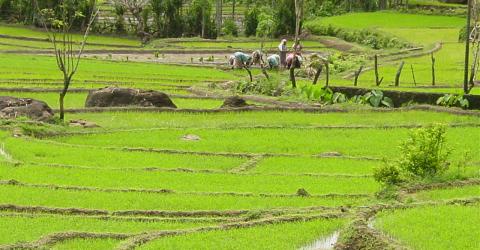
Traditional Irrigation Landscapes in Sri Lanka: Managed Wetlands that Sustain a Rich Biodiversity and Socio-Cultural Heritage
Although there are no natural lakes in Sri Lanka, an array of ancient irrigation tanks (> 10,000) have been constructed to facilitate rice cultivation in the island over the past 2,500 years. The traditional irrigation tank-paddy field integrated wetlands have played a significant role in the cultural and socio-economic aspects of Sri Lanka, since rice has been the staple diet of its communities since historical times. The irrigation tank, paddy fields and the Buddhist temple formed the three essential elements in a traditional village in Sri Lanka. A wide range of traditional water management and agronomic practices have contributed to sustain these integrated irrigation landscapes in the island.
The major irrigation reservoirs (each > 200 ha) cover an area of 7,820 ha, while the seasonal/minor irrigation tanks (each <200 ha) account for 52,250 ha. These man-made wetlands are marvels of hydrological engineering, depicting a high degree of sophistication in their construction and design.
Most of the irrigation tanks form part of a cascading system of tanks, each ranging from about 10 – 200 ha in extent. Apart from the tanks, other wetland habitats in a cascade include seasonally inundated grasslands, reedbeds, marshes and swamp forests in the tank fringes, irrigation canals, and paddy fields. Among these vegetation types, the seasonally inundated fringing forests are rich in tree species that can tolerate submerged conditions, and function as roosting sites of over 40 species of colony-nesting water birds that inhabit the tanks. The irrigation tanks also sustain inland fisheries in the island.
The traditional paddy fields in Sri Lanka include irrigated as well as rainfed systems that occupy over 760,000 ha throughout the island. Paddy fields are characterized by the presence of standing water until the grain ripening stage of the rice crop, hence they can be considered as agronomically managed freshwater marshes. Their structure consists of small fields surrounded by a network of bunds/ levees, streams and/or irrigation canals, and sump ponds. Under irrigated conditions, they are connected with surrounding irrigation tanks, and function as a mosaic wetland ecosystem that harbours a rich biodiversity including aquatic and terrestrial life forms. Over 100 species of water birds including resident and migratory species visit paddy fields mainly during the flooded phase to feed on a diversity of aquatic organisms.
The traditional village life is governed by paddy cultivation, where agronomic practices at each stage of the crop cycle are implemented at auspicious times, characterized by various types of rituals and ceremonies performed by the villagers. Such events bring the entire village community together, and involve traditional songs, music and dance that have been passed down generations.
By Channa Bambaradeniya, Ph.D., Alliance for Sustainable Landscapes Management, Sri Lanka
© Image courtesy of Channa Bambaradeniya